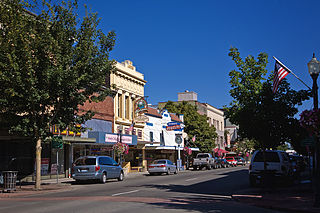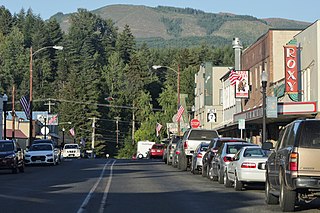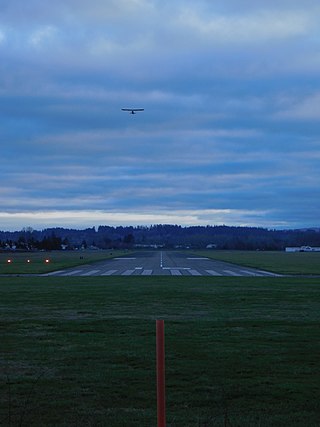
Centralia is a city in Lewis County, Washington, United States. It is located along Interstate 5 near the midpoint between Seattle and Portland, Oregon. The city had a population of 18,183 at the 2020 census. Centralia is twinned with Chehalis, located to the south near the confluence of the Chehalis and Newaukum rivers.

Chehalis is a city in and the county seat of Lewis County, Washington. The population was 7,439 at the time of the 2020 census.

Morton is a city in Lewis County, Washington, United States. The population was 1,036 at the 2020 census.

The Champaign–Urbana Mass Transit District is a mass transit system that operates in the Champaign–Urbana metropolitan area in eastern Illinois. MTD is headquartered in Urbana and operates its primary hub at the intermodal Illinois Terminal in downtown Champaign. In 2022, the system had a ridership of 7,797,100, or about 34,400 per weekday as of the first quarter of 2023.

The Boston-area trolleybussystem formed part of the public transportation network serving Greater Boston in the U.S. state of Massachusetts. It opened on April 11, 1936, with a large network operating for the next quarter-century. Measured by fleet size, the Boston-area system was the third-largest trolleybus system in the United States at its peak, with only the Chicago and Atlanta systems having more trolleybuses than Boston's 463. After 1963, the only remaining portion was a four-route cluster operating from the Harvard bus tunnel at Harvard station, running through Cambridge, Belmont, and Watertown. The Massachusetts Bay Transportation Authority took over the routes in 1964.

Richmond station is an Amtrak intercity rail and Bay Area Rapid Transit (BART) station located in downtown Richmond, California. Richmond is the north terminus of BART service on the Orange Line and Red Line; it is a stop for Amtrak's Capitol Corridor, San Joaquins, and California Zephyr routes. The accessible station has one island platform for the two BART tracks, with a second island platform serving two of the three tracks of the Union Pacific Railroad Martinez Subdivision for Amtrak trains. It is one of two transfer points between BART and Amtrak, along with Oakland Coliseum station.
The Capital Metropolitan Transportation Authority, officially stylized as CapMetro, is a public transportation provider located in Austin, Texas. It operates bus, paratransit services and a commuter rail system known as the Capital MetroRail in Austin and several suburbs in Travis and Williamson counties. In 2022, the system had a ridership of 21,145,300, or about 75,900 per weekday as of the first quarter of 2023.

Salkum is a rural unincorporated community in Lewis County, Washington. The town is located on U.S. Route 12 and is 2.1 miles west of Silver Creek.

The Minnesota Valley Transit Authority, also known by the acronym MVTA, is a public transportation agency that serves seven communities in the southern portion of the Minneapolis–Saint Paul metropolitan area. The agency provides fixed-route and demand-responsive transit within the service area of the communities and to select destinations in the region.

The Metro Red Line is a bus rapid transit line between the Twin Cities suburbs of Bloomington, Minnesota and Apple Valley, Minnesota. The Red Line travels primarily on Minnesota State Highway 77 and Cedar Avenue from the Apple Valley station in Apple Valley, north through Eagan, Minnesota, to the Mall of America station in Bloomington where it connects to the Metro Blue Line. The line has bus rapid transit elements including bus-only lanes, specially branded vehicles, transit signal priority, and dedicated stations.

Plymouth Metrolink is the public transit system that serves Plymouth, Minnesota. Metrolink operates fixed-route bus routes Monday-Friday during peak periods with limited midday service. Most routes serve downtown Minneapolis and the University of Minnesota with one route providing reverse commute service from Minneapolis to employers in Plymouth. Demand-responsive bus service is available seven days a week. Most buses are provided by the Metropolitan Council with First Transit operating the fixed-route service.

The Metro Orange Line is a bus rapid transit line in the Twin Cities, Minnesota operated by Metro Transit. The line operates primarily along Interstate 35W from downtown Minneapolis through Richfield and Bloomington before terminating in Burnsville, Minnesota. The Orange Line provides access to 198,000 jobs with roughly a quarter of them outside downtown Minneapolis. The route serves a mix of stations located in the center of the highway, stations near highway exits, and on-street stations. The line has features typical of bus rapid transit systems with off-board fare payment, articulated buses with extra doors, stations with improved passenger amenities, and transit-only bus lanes on portions of the route.

Timberland Regional Library (TRL) is a public library system serving the residents of western Washington state, United States including Grays Harbor, Lewis, Mason, Pacific, and Thurston counties. Timberland Regional Library has 27 community libraries, 2 cooperative library centers, and 3 library kiosks. It was founded in 1968, following a four-year demonstration project, and is funded through property taxes and timber taxes.

Puyallup station is a train station in the city of Puyallup, Washington, United States. It is served by the S Line, a Sounder commuter rail line operated by Sound Transit that runs from Pierce County to Seattle. The station is located northwest of downtown Puyallup and includes two platforms, several bus bays, and 640 parking spaces. Puyallup station opened on February 5, 2001, on the site of the city's original train depot, which was built in 1877 and demolished in 1974. The station's park and ride was expanded to 1,044 stalls in 2023 with the opening of a new parking garage. In addition to train service, the station is also served by Sound Transit Express and Pierce Transit buses that connect Puyallup to nearby cities.

Pierce Transit, officially the Pierce County Public Transportation Benefit Area Corporation, is an operator of public transit in Pierce County, Washington. It operates a variety of services, including fixed-route buses, dial-a-ride transportation, vanpool and ride-matching for carpools. The agency's service area covers the urbanized portions of Pierce County, part of the Seattle metropolitan area, and includes the city of Tacoma. In 2022, the system had a ridership of 5,562,500, or about 22,200 per weekday as of the first quarter of 2023.

The South Bend Public Transportation Corporation is a municipal bus system that serves the cities of South Bend and Mishawaka, as well as the nearby suburbs of Notre Dame and Roseland, in the very north of the U.S. state of Indiana. It is the most recent incarnation of the South Bend Railway Company, a street railway company that was founded on May 25, 1885. Transpo receives funding from local, state and federal taxes. In 2022, the system had a ridership of 1,145,500, or about 6,300 per weekday as of the first quarter of 2023.
The Twin City Railroad Company was organized in 1912 as successor to the Twin City Light and Traction Company and acquired its subsidiaries, the Chehalis Electric and Traction Company and the Centralia Electric and Traction Company. Until 1936, when the line was abandoned, the company operated the 6.6 mi (10.62 km) electric line that connected the Twin Cities of Chehalis, Washington and Centralia.
The Chehalis, Washington park system is administered by the Chehalis Parks and Recreation Department. Trails that connect Chehalis with locations beyond the city limits are maintained in conjunction with other local jurisdictions, state government agencies, and/or local non-profit groups and volunteers.

Millett Field is the oldest, continuously used public park in Chehalis, Washington and is most noted as home to a Chehalis minor-league baseball team in the early 20th century. The ballfield was regularly used as the central hub of Chehalis sporting activity for decades, including hosting games for several Negro League teams in the 1920s. Located in the city's South Market district, one block north of the NRHP-listed O. B. McFadden House, the 3.3-acre (1.3 ha) park began in 1898.


















